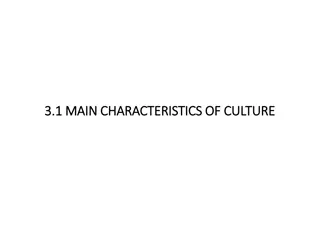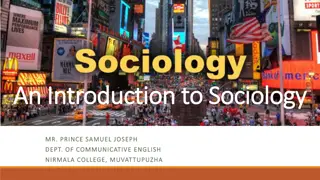Understanding Society: Key Concepts and Characteristics
Society, as defined by various sociologists such as Maclver and Wright, is a complex web of social relationships, norms, and structures. It is characterized by abstractness, mutual interaction, dynamic nature, social control mechanisms, likeness, differences, cooperation, conflict, and a continuous process of becoming. This article explores the fundamental aspects of society, including its definition, composition, characteristics, and the dynamics of social interactions within a community.
Download Presentation

Please find below an Image/Link to download the presentation.
The content on the website is provided AS IS for your information and personal use only. It may not be sold, licensed, or shared on other websites without obtaining consent from the author. Download presentation by click this link. If you encounter any issues during the download, it is possible that the publisher has removed the file from their server.
E N D
Presentation Transcript
DEFINATIONS Maclver It is a web of social relationship. According to Maclver and Page society is a system of usages and procedures of authority and mutual aid of many groupings and divisions, of controls of human behavior and liberties. Wright It is a system of relationships that exists among the individuals of the groups. Linton Any group of people who have lived and worked together long enough to get themselves organized and to think of themselves as a social unit with well defined limits . A.W. Green It is the largest group in which individual have relationships.
The basic characteristics of society Abstractness of Society The term society denotes to a system of social relationship which is invisible and abstract. We can only realize it. Therefore society is abstract. According to Reuter; Just as life is not a thing but a process of living, so society is not a thing but a process of associating. Mutual Interaction and Mutual Awareness Society is a group of people in continuous interaction with each other, It refers to the reciprocal contact between two or more persons. It is a process whereby men interpenetrate the minds of each other . Social interaction is made possible because of mutual awareness. Society consists of people Society is composed of people. Similarly, without people there can be no society, no social relationships, and no social life at all. Society is Dynamic Society is not static; it is dynamic. Changes may take place slowly and gradually or suddenly and abrupt.
Social Control Society has its own ways and means of controlling the behaviour of its members. Society has various formal as well as informal means of social control. It means, society has customs, traditions, conventions and folkways, mores, manners, etiquettes and the informal means of social control. Also it has law, legislation, constitution, police, court, army and other formal means of social control. Likeness and difference in society Society involves both likeness and difference. Society exists among those who have some degree of likeness in mind and in body. F.H. Giddings called this quality of society as consciousness of kind (a sense of likeness). If people are all exactly alike their relationships would be limited.Hense society has both likeness and differences . Difference is always subordinated to likeness in society. Likeness has a predominant share in the constitution of society.
Cooperation and conflict in society: Cooperation and conflict are universal elements in human life. Society is based on cooperation but because of internal differences, there is conflict also among its members. Maclver and Page observed that society is cooperation crossed by conflict . Society is a process and not a product: Society exists only as a time sequence. It is becoming, not a being; a process and not a product (Maclver and Page).
COMMUNITY DEFINATIONS E.S .Bogardus A community is a social group with some degree of we feeling and living in a given area. K Davis The community is the smallest territorial group that can embrace all aspects of life. MacIver and Page A community is an area of social living marked by some degree of social coherence. Ogburn and Nimkoff A community may be thought of as the total organization of social life with in a limited area
ESSENTIAL ELEMENTS OF A COMMUNITY GROUP OF PERSONS DEFINATE GEOGRAPHICAL AREA COMMUNITY SENTIMENTS
CHARACTERSTICS OF COMMUNITY Group of people: Community is a group of human beings. It is not possible to form a community without a group of men and women. Definite locality: A community always occupies a definite geographical area. Locality is the physical basis of community. Without a definite locality, social relations between human beings cannot be established and the we feeling cannot evolve. Community Sentiment: Community sentiment means a feeling of belonging together. It is we feeling among the members. The members of a community speak the same language, conform to the same mores, posses the same sentiment, and have the same attitudes. Likeness The people in a community share a common way of life. Their customs, traditions, mores, language etc. are similar Permanency A community is not temporary like a crowd or a mob. It is relatively stable. It includes a permanent life in a definite place
A particular Name: Every community has some particular name. In the words of Lumley, It points its identity, it indicates reality, it points out individuality, it often describes personality and each community is something of a personality Size: A community may be big or small. Regulation of Relations: Every Community in course of time develops a system of traditions, customs, and morals. Practices, some rules and regulations to regulate the relations of its members. People in a community come together to meet the primary needs through a common set of institutions and organizations. Community is concrete.
ASSOCIATIONS DEFINATIONS MacIver and page An Association is a group organised for the pursuit of interest or group of interest in common. Bogardus An Association is usually working together of people to achieve some purpose. Gillins And Gillins An association is a group of individual united for a specific purpose or purposes held together by recognised or sanctioned mode of procedure and behaviour. Ginsberg An association is a group of social being related to one another by the fact that they possess or have instituted in common organization with a view to securing a specific end
CHARACTERSTICS OF ASSOCIATIONS A group of people An association is created or formed for the attainment of the objectives. Without people there can be no association. Hence, a group of people is an essential condition of an association. Common interests: An association is not a mere collection of human beings. It consists of those individuals who have some interests in common. Co-operative Spirit: An association is based on co-operative spirit of its members. People work together to achieve some common purposes. It gives opportunities to its members to work together to achieve some common purposes Organization: An association is formed of those individuals who are organised in order to fulfill some specific interests. So, an association is known as an organised group.
Some Rules and Regulations: The organization of an association rests upon a particular set of laws. These laws are necessary for regulating the conduct of members belonging to an association. The members of an association follow these rules and regulations. Voluntary membership; The membership of an association is voluntary. It is not compulsory. People voluntarily join in an association for the achievement of their desired objectives. They can also withdraw their membership according to their own wishes. Nature of association An association may be permanent or temporary in nature. Some associations like the state, family, etc. are permanent. Some associations are organized for a very temporary period. For example, the Flood Relief Association is a temporary association.
Institution is an established way of behaving or established forms of procedure. It consists of all the structural components of a society through which the main concerns and activities are organized and social needs such as those for order, belief and reproduction are met. Recognized usage and procedures are known as institutions of Sociology. DEFINATIONS J.H. Fitcher has defined an institution as a relatively permanent structure of social patterns of roles and relations that people enact in certain sanctioned and unified ways for the purpose of satisfying basic social needs. MacIver and Page Institution have been defined as the established form of conditions and procedure characteristic of group activity. Bogardus A social institution is a structure of society that is organized to meet the needs of the people chiefly through well established procedure. Sumner An institution consist of concept(idea ,notion , doctrine, interest)and a structure.
Horton And Hunt An institution is an organized system of social relationships which embodies certain common values and procedures and meets certain basic needs of society. Talcott Parsons Institutions are normative patterns which define what are felt to be, in the given society, proper, legitimate, or expected modes of action or of social relationships .
Characterstis of an Institution Satisfaction of specific needs Each institution satisfy some specific needs . The family meets the need for controlling the reproductive functions , socializing children and providing economic security to the children Prescription of roles Institution prescribe rules and regulations that are to be followed . Marriage as an institution, for e.g. governs the relations between the husband and the wife . Similarly the school or college has its own rules and regulation. Abstractness Institution are abstract in nature . They are neither visible nor tangible. Marriage cannot be kept in museum. Cultural symbol Institution have cultural symbols. The symbols may be either material or non material.eg a country has a flag, an emblem, a national anthem
Universality Social Institutions are Universal and exist in all societies and have been found at all stages of social development Social in nature Institutions come into being due to the collective activities of the people. Institutions are the controlling mechanism Institutions like religion ,morality , state Government law, legislation etc control the behaviour of men. They preserve the social order and give stability to it. Relatively Permanent Institutions normally do not undergo sudden and rapid change.Change take place slowely and gradually in them. Caste , religion
Types of Institutions According to W.G. Sumner (Folkways, 1906), institutions are of two types (1) Crescive: Institutions that take shape in the mores are known as crescive institutions. Property, marriage, religion are all crescive institutions. (2) Enacted Institutions Institutions that are productions of rational invention and intention such as schools, colleges, corpora- tions, banks etc. E.W. Burgess has offered four-fold classification: 1. Cultural institutions for transmitting social heritage like family, school, church (religious institutions). 2. Economic institutions for organizing of services of utility like bank, labor union, commercial and industrial enterprises. 3. Recreational institutions for satisfying human desire of entertainment, amusement and play etc. 4. Social control institutions for solving social problems of society and personality























